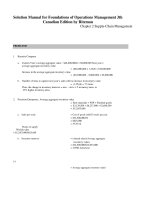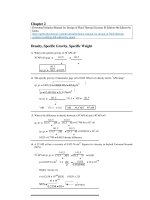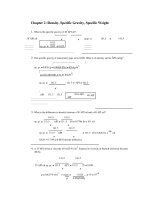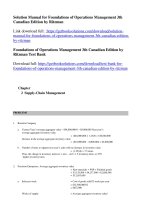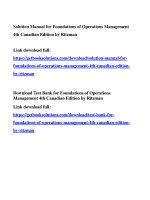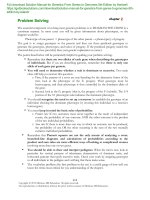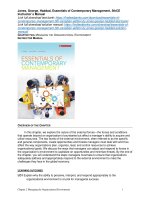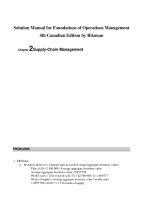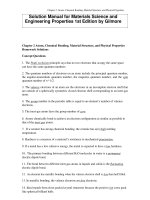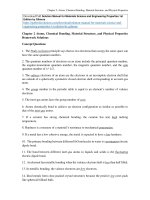Solution manual for foundations of operations management 4th canadian edition by ritzman
Bạn đang xem bản rút gọn của tài liệu. Xem và tải ngay bản đầy đủ của tài liệu tại đây (1.45 MB, 54 trang )
Solution Manual for Foundations of Operations Management
4th Canadian Edition by Ritzman
Link download full:
/>
Download Test Bank for Foundations of Operations
Management 4th Canadian Edition by Ritzman
Link download full:
/>
Chapter
2Supply-Chain Management
PROBLEMS
1. EBI Solar
a. Inventory turnover = (Annual sales at cost)/(Average aggregate inventory value)
Thus, 4.50 = 2 500 000 / Average aggregate inventory value
Average aggregate inventory value = $555 556
Weekly sales = Cost of goods sold / 52 = $2 500 000 / 52 = $48 077
Weeks of supply = Average aggregate inventory value / weekly sales
= $555 556 / 48 077 = 11.56 weeks of supply
b. Average aggregate inventory value = raw material + work-in-process + finished goods
= $100 500 + $25 800 + $16 200 = $142 500
Inventory turnover = (Annual sales at cost)/(Average aggregate inventory value)
= $2 500 000 / $142 500 = 17.54
Weeks of supply = Average aggregate inventory value / weekly sales
= $142 500 / 48 077 = 2.96 weeks of supply
2.
Roll-away Corporation. Average aggregate inventory value can be calculated as:
Average aggregate inventory value
Weeks of supply
a. Sales per week
= Raw materials + WIP + Finished
goods
= $2 470 000 + $1 566 000 + $1 200
000
= $5 236 000
b. Inventory turnover
18
= Cost of goods sold / 52 weeks per year
= $48 000 000 / 52
= $923 077
= Average aggregate inventory value / Weekly sales
(at cost)
= $5 236 000 / $923 077
= 5.7 weeks
= (Annual sales at cost) / (Average aggregate
inventory value)
= $48 000 000 / $5 236 000
= 9.17 turns/year
CHAPTER TWO Supply-Chain Management
3. Sterling Inc.
a.
Part Number
RM-1
RM-2
RM-3
RM-4
WIP-1
WIP-2
FG-1
FG-2
Average
Inventory (units)
20 000
5 000
3 000
1 000
6 000
8 000
1 000
500
44 500
Value ($/unit)
1.00
5.00
6.00
8.00
10.00
12.00
65.00
88.00
Total Value ($)
20 000
25 000
18 000
8 000
60 000
96 000
65 000
44 000
336 000
Average aggregate inventory value: $336 000
b. Average weekly sales at cost
Weeks of supply
c. Inventory turnover
= $6 500 000 / 52
= $125 000
= $336 000 / $125 000
= 2.688 weeks.
= Annual sales (at cost) / Average
aggregate inventory value
= $6 500 000 / $336 000
= 19.34 turns.
4. One product line
Inventory turnover = (Annual sales at cost)/(Average
aggregate inventory value)
10.0 = $985 000 / Average aggregate
inventory value
Average aggregate inventory value = $985 000 / 10 = $98 500
5. A retailer
a.
Sales per week
Weeks of supply
= Cost of goods sold / 52 weeks per year
= $3 500 000 / 52
= $67 308
= Average aggregate inventory value /
Weekly sales (at cost)
= $1 200 000 / $67 308
= 17.8 wk
19
CHAPTER TWO Supply-Chain Management
b.
Inventory turnover
6.
= (Annual sales at cost) /
(Average aggregate inventory value)
= $3 500 000 / $1 200 000
= 2.9 turns/year
Large global automobile manufacturer
a. We must use the break-even equation for evaluating processes:
Q=
F −F
m
b
cb − cm
Q = ($6 million - $4 million) / ($8.00 - $5.00) = 666 667 solenoids. Consequently, the
automobile manufacturer would need to use 666 667 or more solenoids to make a
financial case to retain manufacture of them in-house.
b. If the projection is for less than 666 667 solenoids, the use of the subcontractor becomes
a possibility. However, in doing so, the manufacturer loses some control over the
production of that part. If that part is critical to the end product, relinquishing direct
oversight may not be a good idea. The ability of the subcontractor to deliver on time
and with high quality are also factors to consider. Also, once out of the manufacturing
of that part, it typically will take quite a while to start it back up again, raising issues of
labor skills and equipment. Ethical issues, such as the potential layoffs and the effect on
the community, should also be considered.
7. BlueFin Bank
We use the break-even equation for evaluating two processes:
Q=
F −F
m
b
cb − cm
The key is to solve for the fixed costs of the “make” option,
Fm = Fb + (cb − cm )Q
Fm = $12 million + 0.02(20 million) = $12 400 000. Consequently, if the fixed annual costs
to do the transactions in-house exceed, $12 400 000, BlueFin would be better off using
DataEase.
20
CHAPTER TWO Supply-Chain Management
8. Bennet Company
a. Each supplier’s performance can be calculated as:
Performance
Weighted Rating
Criterion
Weight Supplier A
Supplier B
Supplier C
1. Price
0.2 0.6(0.2) = 0.12 0.5(0.2) = 0.10 0.9(0.2) = 0.18
2. Quality
0.2
0.6(0.2) = 0.12
0.4(0.2) = 0.08
0.8(0.2) = 0.16
3. Delivery
4. Production facilities
& capacity
5. Environmental
protection
6. Financial position
Total weighted score
0.3
0.6(0.3) = 0.18
0.3(0.3) = 0.09
0.8(0.3) = 0.24
0.1
0.5(0.1) = 0.05
0.9(0.1) = 0.09
0.6(0.1) = 0.06
0.1
0.7(0.1) = 0.07
0.8(0.1) = 0.08
0.6(0.1) = 0.06
0.1
0.9(0.1) = 0.09
0.9(0.1) = 0.09
0.7(0.1) = 0.07
0.53
0.77
0.63
b. Suppliers A and C survived the hurdle. Supplier A would receive 45% of the orders and
Supplier C would receive 55% of the orders.
c. Ben’s system provides some assurance that orders are placed with qualified suppliers.
The orders are divided between two suppliers, so there is a ready alternative if a strike,
fire, or other problem prevents one supplier from performing. The system also rewards
suppliers with more orders if they improve performance.
9. Beagle Clothiers. The weights for the four criteria—price, quality, delivery, and flexibility—
should be 0.2, 0.2, 0.2, and 0.4, respectively. The weighted scores are:
Price
Quality
Delivery
Flexibility
Total weighted score
Supplier A
8 × 0.2 = 1.6
9 × 0.2 = 1.8
7 × 0.2 = 1.4
5 × 0.4 = 2.0
6.8
Supplier B
6 × 0.2 = 1.2
7 × 0.2 = 1.4
9 × 0.2 = 1.8
8 × 0.4 = 3.2
7.6
Supplier C
6 × 0.2 = 1.2
7 × 0.2 = 1.4
6 × 0.2 = 1.2
9 × 0.4 = 3.6
7.4
Supplier B should be selected.
21
CHAPTER TWO Supply-Chain Management
DISCUSSION QUESTIONS
1. Wal-Mart’s approach is to generate a competitive situation between suppliers and to drive
down prices. One of the major competitive priorities in Wal-Mart’s business is low cost,
thereby keeping retail prices to a minimum. Wal-Mart is dealing with standardized goods in
high volumes, and consequently uses an efficient supply chain.
Benetton deals with fashion goods that have shorter life cycles. Therefore, Benetton
needs a more flexible supply chain and also more control over the supply channels. In-house
manufacturing operations combined with rapid response suppliers provides the capability to
produce fashion goods quickly.
2. Many of the key suppliers for Autoshare are service-based, including information technology
that track cars, property management firms that own the parking lots, auto mechanics for
preventive maintenance and repairs, and suppliers of fuel. Of course, automobile
manufacturers are critical suppliers to provide new vehicles to replace older cars, ideally with
a more fuel efficient design. In contrast, Boeing has a network of very sophisticated suppliers
that manufacture parts and subsystems, in addition to its own plant network.
Autoshare is working with partners to expand the number of locations to expand
customer service and the value of membership. Thus, its primary focus is on downstream
linkages with property owners to increase access. In parallel, AutoShare’s service suppliers
also need to expand their ability to serve a growing number of locations. In contrast, Boeing
is working to develop upstream linkages with its suppliers—to the point where much the of
the technology development work is their responsibility. As an aircraft designer and
integrator, web-based technologies can improve collaboration during design, the speed of
information exchange, and scheduling once production begins. This is particularly important
as the extent of design and manufacturing work by suppliers continues to expand.
AutoShare is heavily using the web to interact with customers and track usage. In
addition, web-based data exchange also might be used to schedule maintenance and other
background services. Similar to AutoShare, Boeing could include customers in the webbased system, once a new aircraft is launched into production. Here, customized options or
changes could be readily captured into scheduling, and customers could monitor their orders
as they move through the system. The web may also facilitate the more timely collection of
operating performance data for its aircraft in service. Thus, the web can offer a new option
for Boeing to develop closer relationships with its customers.
22
CHAPTER TWO Supply-Chain Management
CASE: WOLF MOTORS *
A. Synopsis
Wolf Motors has just expanded its network of auto dealerships to include its first auto
supermarket where three different makes of cars are sold at the same facility. John Wolf, the
president and owner of the dealership, has identified three factors that have contributed to the
success of the dealerships: volume, “one price-lowest price” concept of pricing, and afterthe-sale service to the cars sold. Focusing on the service aspect, three components are critical
to providing quality after-the-sale service: well-trained technicians, the latest equipment
technologies, and an adequate supply of service parts and materials. Presently each
dealership is responsible for ordering and managing its inventory of parts and service
materials. The recent growth has brought with it both space and financial resource
constraints. John is now wondering what, if anything, can be done with respect to the
purchasing of service parts and materials that would help address some of these concerns.
B. Purpose
This case provides students with the opportunity to investigate the purchasing function of an
organization in the service sector. Students begin to see that the effective management of
materials is not only essential in manufacturing environments but is also critical in
supporting the delivery of quality services.
Students are confronted by a number of issues as they are asked to recommend a suitable
structure for the purchasing function. Included among them are the following:
1. Given the growth in the number of dealerships in the network, should the purchasing
function be centralized to take advantage of certain economics of scale, or should it
remain decentralized in each separate dealership?
2. Given the different categories of service parts that are purchased, supplier management
issues are raised. Some parts may be more appropriately purchased through single-source
contracting, whereas others may be competitively bid on by multiple suppliers. Bid
awards don’t necessarily have to be awarded on the basis of low cost alone. Also some
items may be grouped and purchased from the same supplier using blanket orders.
3. Limited space for inventory storage and limited investment dollars complicate the issues.
Fast, reliable service in repairing and servicing cars is a key factor in the success of the
dealership, but space and dollars limit service part availability to some extent.
4. Finally, students have the opportunity to bring into play basic inventory management
concepts such as an ABC analysis to help determine appropriate levels of inventory
investment and inventory stocking policies. This case can also be used as a lead-in to
Chapter 10, Inventory Management.
*
This case was prepared by Dr. Brooke Saladin, Wake Forest University, as a basis for classroom discussion.
23
CHAPTER TWO Supply-Chain Management
C. Analysis
The analysis of this case can be accomplished in three logical steps. Students should first
address the issue of restructuring the purchasing function. Then the inherent policies and
procedures to carry out the purchasing processes can be addressed, followed by an analysis
of specific inventory management issues that help lead into Chapter 10, Inventory
Management.
Major factors to consider in addressing these steps include:
Presently each individual dealership handles its own purchase and management of service
parts and materials.
The new dealership is an auto supermarket with three different makes of cars sold at the
same location. The purchase of this dealership has led to a tightening of financial
resources. Having three different makes of cars to service has also created a space
constraint in stocking service parts.
Wolf Motors is trying to reduce the total operating costs in order to compete effectively
in a very price competitive market with its “one price-lowest price” strategy, while at the
same time it needs to maintain a high level of service. High service levels have
traditionally been linked to high levels of inventory of spare parts.
There is a need to maintain timely delivery of service parts due to the limited space
available.
There are various categories of parts and materials. One key distinction is that some parts
are available only from the auto manufacturer or its certified dealer/wholesaler. Other
parts and materials (i.e., oil, lubricants, fan belts, and so on) are more generic and can be
purchased from a number of sources, including local vendors.
Parts are not only used to service and repair cars but are also sold over-the-counter to the
do-it-yourself mechanic or other repair garages. Therefore, the overall levels of demand
and supporting inventory must be coordinated among service needs, sales, and special
promotions such as free brake inspections or discounts on oil changes and air-conditioner
service. Weather also plays a role in the demand for parts: extreme cold affects the
electrical/ignition systems, heat affects the air-conditioning, and rain affects the wipers.
1. Structural Issues: Students should first address the structural issues that face Wolf
Motors pertaining to the purchase of parts and materials. These issues include two
categories of decisions: (1) centralized purchasing versus continuing a decentralized
model of letting each dealership purchase and manage its own inventories and (2) the
responsibility relationships purchasing should maintain with inventory management and
control, to include the distribution of parts for service and over-the-counter sales.
Although there is some advantage to be gained by maintaining a decentralized, local
purchasing function, it appears that Wolf Motors has grown to the point where a more
formal central purchasing function is warranted. Wolf’s size should give it some
economy of scale leverage to help maintain low costs and timely deliveries.
Within the purchasing function, personnel could be assigned specific responsibilities
or vendors such as:
Specific auto manufacturers or their certified distributors
Wholesale distributors of generic parts such as alternators, carburetors, or brake pads
Wholesale distributors of consumable materials such as oils, lubricants, or filters
24
CHAPTER TWO Supply-Chain Management
The second structural issue pertains to the level of integration that needs to be
structured and maintained between purchasing, inventory stocking and control, and parts
distribution. Should these be separate functions that “hand off” the responsibility for
materials as they flow through the system, or should an integrated supply chain be
implemented? The issue is one of being able to balance the purchasing costs, inventory
carrying costs, distribution/logistics costs, and target service levels.
2. Policies and Procedures: After the structural issues have been discussed, students should
consider alternative purchasing options that are available for procuring parts. Given that
the parts and materials being purchased differ quite a bit with respect to availability,
usage, costs, and delivery lead time, the policies and procedures used to order various
parts may be different. Alternative policies that may be used include:
Competitive bidding
Single-source contracting
Blanket orders
Open-ended orders
Of course, these approaches are not mutually exclusive and may be combined for
certain categories of parts. Students should discuss how each of these alternatives may be
used for different groups of parts and materials. Going out for competitive bids would be
most appropriate for “commodity” type items that are readily available from a number of
vendors. Given that other aspects of the service, such as reliability and dependability, are
comparable, then a competitive bid will help reduce purchase costs. Where the quality of
the parts and/or service provided differs, then a single-source contract may be warranted.
This should lead to a partnership arrangement that is beneficial to both parties.
Blanket orders are used when a number of parts are to be purchased from a single
supplier. Blanket orders help reduce the overall ordering and distribution costs by
grouping items under a single order. This may be an appropriate procedure for purchasing
oils and lubricants from a local supplier or for ordering “factory certified” parts from a
manufacturer or its designated distributor.
Open-ended orders provide flexibility in allowing items to be added or deleted from
an order or for the time period of the order to be extended, such as in a blanket order of
oil. Through this discussion students will begin to see that all items should not be ordered
by the same procedure. Factors such as the item’s availability, relative importance, usage
levels, and costs will have a significant impact on the way the item should be procured.
This has implications also in determining how the purchasing function’s performance
should be measured and evaluated. Just getting the lowest price is no longer good
enough. Other measures of performance, such as product quality, reliable on-time
delivery, and ordering flexibility with respect to the size and timing of the order, may be
more important than price. This is an important lesson the students should understand.
3. Inventory Management Issues: The financial resource and space constraint issues brought
out in the case provide the opportunity to discuss the close relationship and necessary
integration that purchasing must have with inventory management. Suggested inventory
management policies that can be discussed include the three important factors in making
inventory stocking-level decisions. These include costs, delivery lead time, and space
25
CHAPTER TWO Supply-Chain Management
required/available. Students should see that each of these factors can be used to prioritize
the different parts and materials to be inventoried.
You can discuss the different costs incurred in ordering and carrying inventory to set
students up for the trade-offs to be discussed in the Inventory Management chapter.
You can bring out the issue of total investment in inventory over time to open the
door for a discussion of the ABC analysis in the Inventory Management chapter.
There is the issue of where to stock different parts in the storeroom or warehouse.
Frequently used material should be stored in easily accessed locations, and a random
location system will minimize space requirements.
You could also introduce how inventories can be categorized, such as building
anticipation stocks for promotions and seasonal use.
Finally, perhaps implementing an effective EDI link between locations and suppliers
would reduce delivery lead time.
The amount of time and depth of analysis pertaining to the discussion of inventory
management issues will depend on how you wish to lead into the chapter on inventory
management. You should at least make sure the students see the necessary integration
between purchasing and inventory management policies.
D. Recommendations
How the case is used will determine the level of detail you should expect with respect to any
recommendations students may make. When used as an in-class exercise without any prior
preparation by the students, the focus of the case should be on discussing the issues and
recognizing the trade-offs that need to be made in the decisions. If given more time to read
and analyze the case, typical recommendations to expect include:
1. Some form of centralization of the purchasing function
2. Development of partnership agreements for “key” parts that perhaps may lead to single
sourcing
3. The use of blanket orders to reduce ordering costs and to limit the number of suppliers
4. Open-ended ordering agreements, especially in the “commodity” type materials that can
be sourced locally to reduce lead times and minimize inventory investment
5. Perhaps the establishment of a central warehouse facility to reduce overall space
requirements while maintaining parts availability in a timely manner
6. Conducting an analysis of inventory cost trade-offs to minimize total costs of inventory
policies
E. Teaching Suggestions
This case can be used as either an in-class “cold-call” exercise or an overnight reading and
analysis exercise. In either case the class discussion flows well when the instructor follows
the order of the discussion questions at the end of the case. The level of detail necessary to
make this a good decision case is not present. The case was designed to act as a vehicle to
introduce the issues that pertain to purchasing and to show students that the issues are similar
26
CHAPTER TWO Supply-Chain Management
in both services and manufacturing. Therefore, it is best to begin the discussion by first
focusing on how the purchasing function should be organized. Then focus the students on
specific policies and procedures that Wolf may implement for different categories of parts.
Finally, if time permits, you can begin to introduce some inventory management issues and
show how the inventory function interacts with purchasing.
27
CHAPTER TWO Supply-Chain Management
CASE: BRUNSWICK DISTRIBUTORS
There are two options that need to be considered in the analysis of Brunswick Distribution, Inc.
(BDI). The accompanying spreadsheet program, Brunswick Financial Analyzer, can be used to
explore various areas where operations can help firms to become more profitable. The program
can take any data as a starting point and show how various changes (or shocks) to the status
quo will affect the financial measures. It uses the well-known DuPont analysis as a basis for its
calculations.
This Instructor’s Manual contains full financial statements to accompany the Dupont analysis
using the spreadsheet program. The student should use the Financial Analyzer spreadsheet to do
a DuPont analysis for Brunswick.
A summary of the conclusions from the analysis of the two options posed in the case
follow. Option 1: Invest in new warehouse facilities
•
•
•
•
Inventory turnover improves marginally with this option. (See the DuPont
analysis ratios).
Net income goes up but not enough to make the new investment attractive.
Declining returns ⇒ The DuPont analysis indicates worsening ratios if this option
is adopted. (See the DuPont analysis ratios).
The investment would put Brunswick in a precarious debt to equity situation.
Option 2: Streamlining the order fulfillment system.
•
•
•
•
•
28
The basic system results in lower profits than the status quo and poor financial ratios. It is
clearly not the better of the two alternatives in this option. This alternative can be
discarded in favor of the fully integrated alternative.
In this case of the fully integrated system, the DuPont analysis shows improving results
in all the ratios with the exception of the sales to total assets ratio.
Operational measures are mixed. Note that the inventory turns measure actually go down.
While inventory valuation goes down (because of the reductions in direct labor costs),
the cost of good sold goes down further (because of reductions in shipping costs as well).
This points out the weakness in the inventory turns measure when looking at an aggregate
inventory. Operationally, it is better to “ measure each item’s inventory in terms of
physical “units” and its demands also in “units.” The problem, of course, is getting to an
aggregate measure of inventory turns because of the conflicts in units of measure.
The cash cycle has deteriorated largely because of the decrease in accounts
payable. Brunswick needs to work on getting it’s A/R days and inventories down.
The fully integrated option increases the leverage ratios but not as substantially as
in Option 1.
CHAPTER TWO Supply-Chain Management
•
Another reason why Option 2 is the better than Option 1 is its impact on the stock market
performance measures.
While Option 2 – fully integrated system – dominates Option 1, it does not improve the
inventory problems at Brunswick. “Inventory days” goes up and “inventory turns” go down.
Brunswick may decide to take Option 2 for other reasons. This option may improve customer
service and drive increases in customer demands in the future. The analysis of these two options
shows the tradeoff in attempting to build market share (Option 1) and becoming more efficient
(Option 2). It should be pointed out to the students that the Dupont analysis is a short-term
analysis. It is debatable which of the two options may have more long-term benefits.
Educational objectives
•
•
•
To critically examine the inter-related activities of marketing, finance and operations.
To study how seemingly small changes in various aspects of the business affect return on
equity and financial measures.
To emphasize that operational changes that affect the cost of goods sold (such as direct
materials costs or labor costs) can have an effect on the firm’s inventory measures because
of the way inventory is valued, even if the actual stock of inventory remains unchanged.
DISCUSSION
Option 1
Income statement
•
This option increases annual revenue by $3.6 million.
•
This option would increase costs by a total of $1,717,000, split up between shipping
($955 thousand), direct material ($358 thousand), and direct labor cost ($404 thousand).
•
Annual depreciation works out to be $500,000, which is computed as straight-line
depreciation of the $10 million investment for 20 years. ($10 million/20)
•
Annual interest is computed at the rate of 11%. (11%*$12 million = $1,320,000)
Balance sheet
•
$1.5 million in accounts receivable.
•
$10 million investment in plant and equipment.
•
$2 million in property.
•
The Financial Analyzer assumes that the new level of inventory investment is equal to the
old level, plus direct changes (plus or minus) in the shock column, plus one-half the total
29
CHAPTER TWO Supply-Chain Management
of the changes to the direct materials on the Income Statement (plus or minus) and the
changes to the direct labor on the Income Statement (plus or minus). The Financial
Analyzer will automatically do this computation, given the inputs on the Income
Statement and the direct inventory shock. Here we have assumed that direct materials
changes and the labor changes take place gradually over the course of the year so that
the average level is one half of the total.
•
On the liability side accounts payable is increased by the amount of the interest from the
new loan, adjusted downward for savings in materials and labor, and adjusted for any net
changes in taxes. Once the annual interest is entered in the “shock” column, the
Financial Analyzer does the computation for you.
•
The entire $12 million is assumed to be a long-term loan agreement.
See the complete spreadsheet analysis for Option 1.
Option 2
This option would contribute 16% in direct cost savings for the fully integrated system which is
computed as 16% * Cost of sales (16%*$21,620,000). This works out to be $3,460,000 in annual
savings split up equally for direct material and direct labor cost – ($1,730,000).
Income Statement
•
Annual depreciation works out to be $1,600,000, which is computed as straight-line
depreciation of the $8 million investment for five years. ($8M/5)
•
Annual interest is computed at the rate of 10%. 10%*$8 million = $800,000.
Balance Sheet
•
$8 million investment in plant and equipment.
•
On the liability side, accounts payable is computed as being made up of direct material
costs net of savings and the additional amount payable on the higher taxes resulting
from the savings.
•
The entire $8 million is assumed to be a long-term loan agreement.
See the complete spreadsheet analysis for the two alternatives of Option 2.
30
CHAPTER TWO Supply-Chain Management
Other Issues to Discuss
One of the biggest issues facing BDI is the predictability of sales. Since orders do not come in
from retailers in a timely fashion, considerable emphasis is placed on forecasting sales for
manufacturers. This forecasting is largely historical and therefore does not reflect the changes
that have occurred over the past two years. In order to better determine levels of safety stock, a
better integration of the supply chain is required. Getting the end customer involved by
showcasing the product in a kitchen-like setting and acquiring forward -looking information
from the end user might help Brunswick in determining demand. Perhaps a better approach,
however, is to implement vendor managed inventory programs with retailers and using their
forecasts of sales in various product lines. This could somewhat alleviate the delayed ordering
from the retailer and allow more accurate 60/90/120 ordering to the manufacturer.
With the additional business, and the extra product lines, BDI has acquired some
deadweight. The company already supplies the majority of high-end appliances and the new
lines have cut in to the profit margins that the company has historically observed. Other financial
concerns, such as the poor cash cycle, can be looked at in one of two ways: either bring accounts
receivable and accounts payables closer in line by delaying payables whenever possible and
placing tighter controls on receivables, or, increase liquidity by obtaining a larger operating loan.
31
CHAPTER TWO Supply-Chain Management
TN1. Invest in New Warehouse Facilities
Without Shock
Inc. Stmt.
$ 000's
Revenue
$33,074
Cost of Goods Sold
Shipping costs
Direct materials
Direct Labor & other
Total
$8,931
$5,963
$6,726
$21,620
Gross Profit
With Shock
$ 000's
$3,600
$955
$358
$404
$762
$36,674
$9,886
$6,321
$7,130
$23,337
$11,454
Operating Expenses
Selling Expenses
Fixed Expenses
Earnings Before Interest and Taxes
$500
$2,294
$10,343
$1,611
Interest Expense
$631
Earnings Before Taxes
$2,994
$1,320
$1,951
$980
40%
$392
Net Income
$1,043
$417
$588
Dividends
$626
$0
$0
Contribution to Retained Earnings
# of Shares Outstanding
Stock Price as of
$3,820
$4,229
$1,794
$9,843
Total
Taxes @
$13,337
$3,820
$4,229
Depreciation
32
Shock
$ 000's
$588
1/31/1997
350
$5.00
$626
350
$5.00
CHAPTER TWO Supply-Chain Management
TN1 (continued)
Balance Sheet
Assets
Without Shock
With Shock
Liabilities
Without Shock
Shock
Current Assets
Inventory
$6,789
Total Inventory
Cash
Accounts Receivable
Other Current Assets
Total CA
$7,170
$6,789
$3,223
$5,603
$1,381
$1,500
With Shock
Shock
Current Liabilities
Accounts Payable
Short-term Liabilities
Notes Payable
$7,170
Short-term Debt
Total STL
$3,223
$7,103
$1,381
$16,996
$18,877
Long-term Liabilities
Long-term Loans
Bonds
Other Liabilities
Total LTL
$1,282
$1,320
$1,099
$4,159
$3,389
$0
$1,099
$4,159
$6,540
$7,523
8647.2
$12,000
$19,523
$0
$0
$7,523
$19,523
Long-term Assets
Property
Plant and Equipment, net
$3,179
$8,995
Long-term Investments
Total LTA
$1,000
Total Assets
$2,000
$10,000
$13,174
$30,170
$5,179
$18,995
Total Debt
$1,000
Equity
$25,174 Common Stock
Paid-in-excess
$44,051
Retained Earnings
$14,063
$1,750
$428
$13,929
Total Equity
Total Debt & Equity
$28,170
$1,750
$0
$428
$13,703
$16,107
$15,881
$30,170
$44,051
33
CHAPTER TWO Supply-Chain Management
TN1 (continued)
DuPont Analysis
ROE
ROA
NPM
TATO
Operational Measures
Current ratio
Inventory Turns
WC to Sales
Fixed Asset Turnover
Liquidity
A/R Days
A/P Days
Inventory Days
Cash Cycle
Financial Performance
Debt- Asset Ratio
Debt-Equity Ratio
Times Interest Earned
Gross Profit Margin
Materials %
Labor %
Stock Market Performance
EPS
Earnings / Price
Market Value/ Book V
Without Shock
3.7%
3.2%
1.8%
109.6%
With Shock Change
3.9%
UP
= Net Income / Equity
2.4%
DOWN = EBIT / Total Assets
1.7%
DOWN = Net Income / Sales
83.3%
DOWN = Sales / Total Assets
2.60
3.2
31.6%
111.8%
2.18
3.3
27.9%
103.6%
DOWN
UP
DOWN
DOWN
= Current Assets / Current Operating Liabilities
= COGS / Inventory
= Operating WC / Sales
= Net Property, Plant, Equipment / COGS
61.8
78.5
114.6
98.0
55.8
195.7
112.1
(27.8)
DOWN
UP
DOWN
DOWN
= Accounts Rec. / (Sales / 365)
= # of days to collect credit charges
= Accounts Pay. / (Direct Materials / 365)
= Inventory / (COGS / 365)
= A/R Days - A/P Days + Inventory Days
46.6%
87.3%
2.55
34.6%
18.0%
20.3%
63.9%
177.4%
1.53
36.4%
17.2%
19.4%
UP
UP
DOWN
UP
DOWN
DOWN
= Debt / Total Assets
= Debt / Equity
= EBIT / Interest
= Gross Profit / Sales
= Direct Materials / COGS
= Direct Labor / COGS
1.68
0.34
0.11
1.79
0.36
0.11
UP = Earnings / # of shares outstanding
UP = EPS / Market Price
UP = Market Value / Book Value of Equity
Many of the financial and performance ratios degrade relative to the current status. Troubling, however is the debt-equity increase to 177.4%. This
is an unreasonably high leverage and may pose difficulties for Brunswick to obtain financing. Inventory turns essentialy do not improve,
34
CHAPTER TWO Supply-Chain Management
TN2. Streamlining the Order Fulfillment System – Basic
Without Shock
$ 000's
$ 000's
Inc. Stmt.
Revenue
Shock
$ 000's
With Shock
$33,074
$33,074
Cost of Goods Sold
Shipping costs
Direct materials
Direct Labor & other
Total
$8,931
$5,963
$6,726
$21,620
Gross Profit
($1,081)
($1,081)
($1,081)
$7,850
$5,963
$5,645
$19,458
$11,454
Operating Expenses
Selling Expenses
Fixed Expenses
$3,820
$4,229
Depreciation
Earnings Before Interest and Taxes
$631
Earnings Before Taxes
$2,954
$11,803
$1,813
$530
$1,161
$980
40%
$392
Net Income
$652
$261
$588
Dividends
$391
$0
$0
Contribution to Retained Earnings
# of Shares Outstanding
Stock Price as of
$1,160
$3,820
$5,029
$1,611
Interest Expense
Taxes @
$800
$1,794
$9,843
Total
$13,616
$588
1/31/1997
350
$5.00
$391
350
$5.00
35
CHAPTER TWO Supply-Chain Management
TN2 (continued)
Balance Sheet
Assets
Without Shock
With Shock
Liabilities
Without Shock
Shock
Inventory
$6,789
Total Inventory
Cash
Accounts Receivable
Other Current Assets
Total CA
$6,789
$3,223
$5,603
$1,381
$16,996
Long-term Assets
Property
$3,179
Plant and Equipment, net
$8,995
Long-term Investments
Total LTA
$1,000
Total Assets
$6,249
$3,223
$5,603
$1,381
Current Liabilities
Accounts Payable
Short-term Liabilities
Notes Payable
$6,249
Short-term Debt
Total STL
Long-term Liabilities
Long-term Loans
$16,456
Bonds
Other Liabilities
Total LTL
$3,179
$5,300
$30,170
$530
$1,099
$4,159
$600
$0
$1,099
$4,159
$6,540
$7,523
5857.8
$5,300
$12,823
$0
$0
$7,523
Total Debt
$12,823
$14,063
Equity
$18,474 Common Stock
Paid-in-excess
$1,750
$18,681
$1,750
$0
$428
$428
$34,930
Retained Earnings
$13,929
Total Equity
Total Debt & Equity
36
$1,282
$14,295
$1,000
$13,174
With Shock
Shock
Current Assets
$14,071
$16,107
$16,249
$30,170
$34,930
CHAPTER TWO Supply-Chain Management
TN2 (continued)
DuPont Analysis
ROE
ROA
NPM
TATO
Operational Measures
Current ratio
Inventory Turns
WC to Sales
Fixed Asset Turnover
Liquidity
A/R Days
A/P Days
Inventory Days
Cash Cycle
Financial Performance
Debt- Asset Ratio
Debt-Equity Ratio
Times Interest Earned
Gross Profit Margin
Materials %
Labor %
Stock Market Performance
EPS
Earnings / Price
Market Value/ Book V
Without Shock
3.7%
3.2%
1.8%
109.6%
With Shock
2.4%
1.9%
1.2%
94.7%
Change
DOWN
DOWN
DOWN
DOWN
= Net Income / Equity
= EBIT / Total Assets
= Net Income / Sales
= Sales / Total Assets
2.60
3.2
31.6%
80.8%
2.81
3.1
32.0%
89.8%
UP
DOWN
UP
UP
= Current Assets / Current Operating Liabilities
= COGS / Inventory
= Operating WC / Sales
= Net Property, Plant, Equipment / COGS
61.8
78.5
114.6
98.0
36.7
117.2
142.3
DOWN
UP
UP
= Accounts Rec. / (Sales / 365)
= # of days to collect credit charges
= Accounts Pay. / (Direct Materials / 365)
= Inventory / (COGS / 365)
= A/R Days - A/P Days + Inventory Days
46.6%
87.3%
2.55
34.6%
18.0%
20.3%
53.5%
115.0%
1.56
41.2%
UP
UP
DOWN
UP
17.1%
DOWN
1.68
0.34
0.11
1.12
0.22
0.11
= Debt / Total Assets
= Debt / Equity
= EBIT / Interest
= Gross Profit / Sales
= Direct Materials / COGS
= Direct Labor / COGS
DOWN = Earnings / # of shares outstanding
DOWN = EPS / Market Price
DOWN = Market Value / Book Value of Equity
The basic level option results in less profit per year and worsening financial ratios. Average inventories increase and inventory turns decrease.
37
CHAPTER TWO Supply-Chain Management
TN3. Streamlining the Order Fulfillment System – Full System
Without Shock
$ 000's
$ 000's
Inc. Stmt.
Revenue
With Shock
$33,074
$33,074
Cost of Goods Sold
Shipping costs
Direct materials
Direct Labor & other
Total
$8,931
$5,963
$6,726
$21,620
Gross Profit
($1,730)
($1,730)
($1,730)
$7,201
$5,963
$4,996
$18,160
$11,454
Operating Expenses
Selling Expenses
Fixed Expenses
$3,820
$4,229
Depreciation
Earnings Before Interest and Taxes
$631
Earnings Before Taxes
$3,394
$12,243
$2,671
$800
$1,431
$980
40%
$392
Net Income
$1,240
$496
$588
Dividends
$744
$0
$0
Contribution to Retained Earnings
# of Shares Outstanding
Stock Price as of
$1,600
$3,820
$5,029
$1,611
Interest Expense
Taxes @
$14,914
$800
$1,794
$9,843
Total
38
Shock
$ 000's
$588
1/31/1997
350
$5.00
$744
350
$5.00
CHAPTER TWO Supply-Chain Management
TN3 (continued)
Balance Sheet
Assets
Without Shock
With Shock
Liabilities
Without Shock
Shock
Inventory
$6,789
Total Inventory
Cash
Accounts Receivable
Other Current Assets
Total CA
$6,789
$3,223
$5,603
$1,381
$16,996
Long-term Assets
Property
$3,179
Plant and Equipment, net
$8,995
Long-term Investments
Total LTA
$1,000
Total Assets
$5,924
$3,223
$5,603
$1,381
Current Liabilities
Accounts Payable
Short-term Liabilities
Notes Payable
$5,924
Short-term Debt
Total STL
Long-term Liabilities
Long-term Loans
$16,131
Bonds
Other Liabilities
Total LTL
$3,179
$8,000
$30,170
$1,282
$800
$1,099
$4,159
$456
$0
$1,099
$4,159
$6,540
$7,523
5714
$8,000
$15,523
$0
$0
$7,523
Total Debt
$15,523
$14,063
$21,237
$16,995
$1,000
$13,174
With Shock
Shock
Current Assets
Equity
$21,174 Common Stock
Paid-in-excess
$1,750
$1,750
$0
$428
$428
$37,305
Retained Earnings
$13,929
Total Equity
Total Debt & Equity
$13,890
$16,107
$16,068
$30,170
$37,305
39
CHAPTER TWO Supply-Chain Management
TN3 (continued)
DuPont Analysis
ROE
ROA
NPM
TATO
Operational Measures
Current ratio
Inventory Turns
WC to Sales
Fixed Asset Turnover
Liquidity
A/R Days
A/P Days
Inventory Days
Cash Cycle
Financial Performance
Debt- Asset Ratio
Debt-Equity Ratio
Times Interest Earned
Gross Profit Margin
Materials %
Labor %
Stock Market Performance
EPS
Earnings / Price
Market Value/ Book V
Without Shock
3.7%
3.2%
1.8%
109.6%
With Shock Change
4.6%
UP
= Net Income / Equity
3.3%
UP
= EBIT / Total Assets
2.2%
UP
= Net Income / Sales
88.7%
DOWN = Sales / Total Assets
2.60
3.2
31.6%
93.3%
2.82
3.1
31.5%
111.1%
UP
DOWN
DOWN
UP
= Current Assets / Current Operating Liabilities
= COGS / Inventory
= Operating WC / Sales
= Net Property, Plant, Equipment / COGS
61.8
78.5
114.6
98.0
27.9
119.1
153.0
DOWN
UP
UP
= Accounts Rec. / (Sales / 365)
= # of days to collect credit charges
= Accounts Pay. / (Direct Materials / 365)
= Inventory / (COGS / 365)
= A/R Days - A/P Days + Inventory Days
46.6%
87.3%
2.55
34.6%
18.0%
20.3%
56.9%
132.2%
1.87
45.1%
UP
UP
DOWN
UP
15.1%
DOWN
1.68
0.34
0.11
2.13
0.43
0.11
= Debt / Total Assets
= Debt / Equity
= EBIT / Interest
= Gross Profit / Sales
= Direct Materials / COGS
= Direct Labor / COGS
UP = Earnings / # of shares outstanding
UP = EPS / Market Price
UP = Market Value / Book Value of Equity
The fully integrated option dominates the basic option as well as Option 1. The financial ratios are beter, however none of the options
addresses the issue of inventory turns. Brunswick may decide on Option 2: Full Implementation for otjher reasons, primarily customer service
that may pay off in more customers in the future.
40
